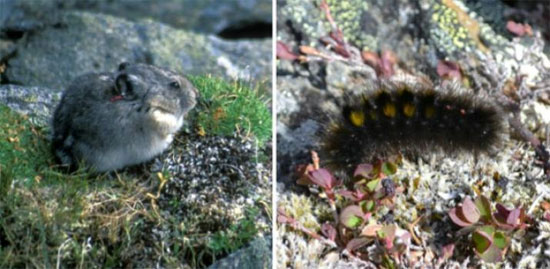Caterpillars and pika share a scarce food source in the Arctic
(Who can think that two species are very different, one is a small insect, and one is a mountain mammal that can develop an agreement to share food at Far away from the North?
The University of Alberta researchers were really surprised, when they discovered an unusual reaction of pika, with clusters of plants that once had caterpillars of a common species in the highlands of Arctic overflow.
Isabel C.Barrio analyzed the way both herbivores, moths, and pika compete for the vegetation in the highlands of the Southwest. Yukon. The caterpillars come out of the cocoon in the winter right after the snow melts in June. The following weeks, pika begin to collect and store food in their winter caves. To experiment, Barrio changed the number of caterpillars released on small plots surrounding pika caves.

Pika (left) and caterpillar (right).
'We noticed that the pika who loved the grass before was released with caterpillars , ' Barrio said. 'We think the caterpillar's feces are like a natural fertilizer that makes the grass look good and attract more pika.'
Biology professor David Hik of the University of Alberta, who oversees the study, said that the research results are in contrast to what the research team expects.
'Often you will guess that increasing the number of caterpillars will have a negative impact on the pika , ' Hik said. 'But there are very few pika in the area that really like the grass that was eaten by moths before.'
The researchers say that it is unusual for these two very different herbivores - an insect in its larval state and a mammal - to react positively to each other in problems of finding food to survive
The caterpillars that exist in the form of larvae do not have wings for 14 years, they will shelter in a cocoon during the last long winter before molting to become pelts (moths). bear moth), and only survive for 24 hours.
The pika does not hibernate and collects food stored in their nest. The territory collecting food of this species includes areas around the cave and surrounding area, covering an area of up to 700m2.
Researchers say they will continue to study the relationship between pika and caterpillars to explore the long-term effects on increased insect populations and competition for scarce food sources in the domain environment. Northern mountains.
Barrio is the lead author of this research collaboration project. Research results were published in Biology Letters on April 24.
- Why is Pika rabbit named
- Arctic fox - beautiful animals eat their own feces
- Tadpoles also eat cannibalism when food is scarce
- Painted with sea berries from insects
- FAO calls for investment in growing insects for food
- Out of food, the orangutan hunts loris
- Caterpillars fake snakes escaping predators
- Caterpillars wear spider mite
- Caterpillars are evolving to cope with climate change
- White bears hunt birds
- Iceberg - Solution for the water resource crisis
- The Arctic Ocean emits greenhouse gases
 Why do potatoes have eyes?
Why do potatoes have eyes? 'Tragedy' the world's largest carnivorous life: Death becomes ... public toilet
'Tragedy' the world's largest carnivorous life: Death becomes ... public toilet Tomatoes were once considered 'poisonous' for 200 years
Tomatoes were once considered 'poisonous' for 200 years Detecting microscopic parasites on human face
Detecting microscopic parasites on human face